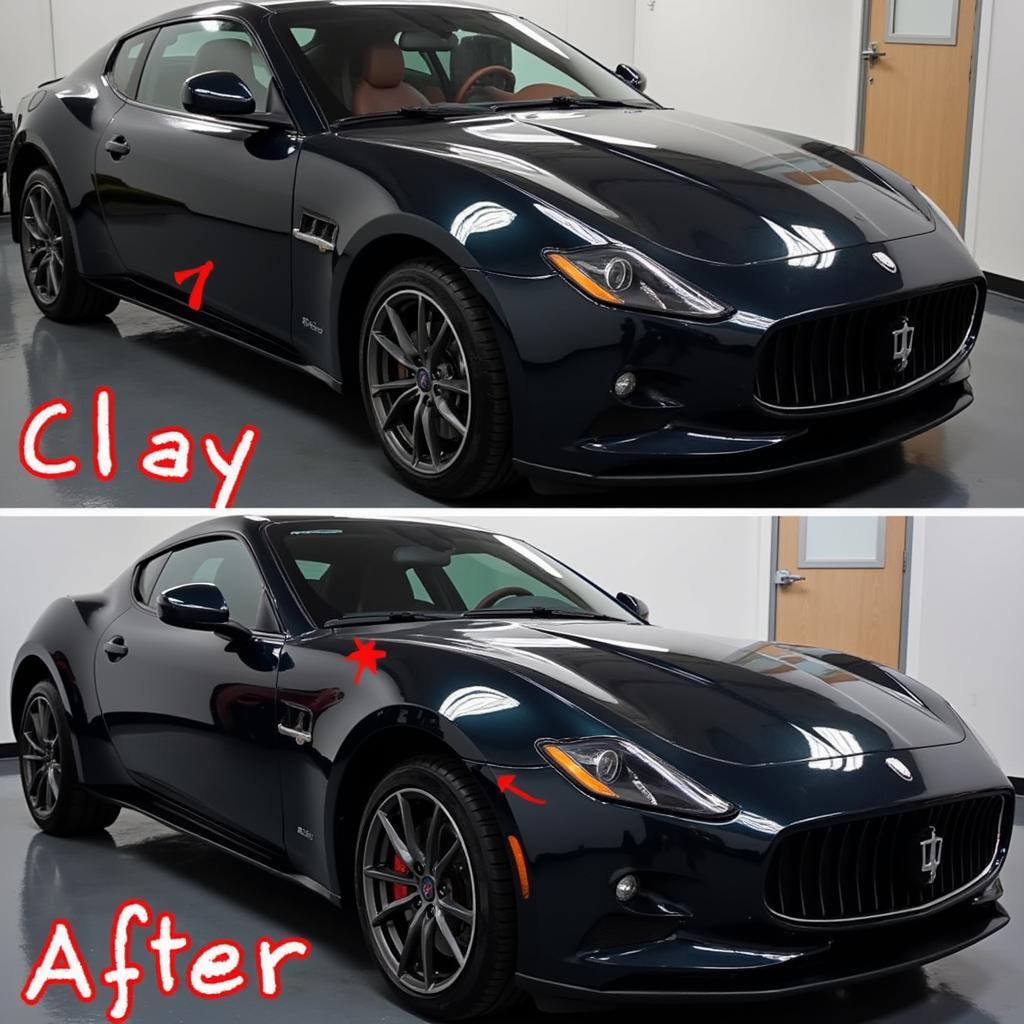Clay For Car Detailing is essential for achieving a truly flawless finish. It’s a crucial step that goes beyond regular washing and waxing, removing embedded contaminants that washing alone can’t tackle. This guide delves into everything you need to know about using clay for car detailing, from choosing the right clay bar to achieving professional-level results. After reading this, your car will thank you with its mirror-like shine.
Detailing clay is a specially formulated resin that safely lifts bonded contaminants from your car’s paint, glass, and smooth plastic surfaces. These contaminants, often invisible to the naked eye, include industrial fallout, tree sap, brake dust, and even overspray paint. They create a rough texture that dulls the finish and prevents wax from adhering properly. Using clay for car detailing removes these imperfections, leaving a perfectly smooth surface for polishing and waxing. Think of it as giving your car’s exterior a deep cleanse, restoring its original luster and making it feel incredibly smooth. Check our range of detailing kits car care.
Why Use Clay for Car Detailing?
Regular washing simply cannot remove all the contaminants that bond to your car’s paint. These microscopic particles create a rough surface, making your car look dull and less vibrant. Claying removes these embedded contaminants, restoring the paint’s smoothness and enhancing its shine.
Benefits of Using Clay:
- Enhanced Shine: Clay removes the microscopic imperfections that dull your paint, revealing a deeper, richer shine.
- Smoother Paint: Experience the feeling of truly smooth paint after claying. It’s a noticeable difference.
- Improved Wax Adhesion: A smooth surface allows wax to bond more effectively, providing longer-lasting protection.
- Restores Paint Clarity: Clay helps to restore the original clarity and depth of your car’s paint color.
Choosing the Right Clay for Your Car
There are various types of clay available, ranging from traditional clay bars to more modern clay mitts and towels. Choosing the right one depends on your experience level and preference.
Types of Clay:
- Clay Bars: The traditional option, offering excellent cleaning power.
- Clay Mitts: Easier to use than clay bars, especially for larger vehicles.
- Clay Towels: Similar to clay mitts, offering a larger surface area for faster application.
How to Use Clay for Car Detailing
Using clay might seem intimidating, but it’s a straightforward process. Follow these steps to achieve professional-level results.
- Wash and Dry Your Car: Ensure your car is thoroughly cleaned and dried before claying.
- Knead the Clay: Soften the clay by kneading it in your hands.
- Lubricate the Surface: Spray a generous amount of clay lubricant onto a small section of the car’s paint.
- Glide the Clay: Gently glide the clay back and forth over the lubricated area until it feels smooth.
- Fold and Knead: Regularly fold and knead the clay to expose a fresh surface.
- Wipe Clean: Wipe the residue with a microfiber towel.
- Repeat: Repeat steps 3-6 for the entire car.
Common Mistakes to Avoid When Using Clay
While claying is a relatively simple process, there are some common mistakes to avoid.
- Using Clay on a Dirty Car: Never use clay on a dirty car. It can grind contaminants into the paint, causing scratches.
- Not Using Enough Lubricant: Insufficient lubrication can cause the clay to stick to the paint, potentially causing marring.
- Dropping the Clay: If you drop the clay, discard it immediately. Contaminants picked up from the ground can scratch your car’s paint.
Looking to enhance your chrome details? Check out our guide on chromed car emblem car logo details.
Maintaining Your Car’s Finish After Claying
After claying, your car’s paint is perfectly prepped for polishing and waxing. These steps will further enhance the shine and protect the paint from future contamination.
Protecting Your Paint:
- Polish: Polishing removes minor imperfections and enhances the gloss of the paint.
- Wax or Sealant: Applying a wax or sealant provides a protective layer that repels contaminants and maintains the shine.
Looking for professional car detailing products? Check out our selection of car detailing products essex.
Conclusion
Clay for car detailing is a game-changer for anyone looking to achieve a truly flawless finish. By removing embedded contaminants, clay restores the paint’s smoothness and enhances its shine, creating a perfect canvas for polishing and waxing. By following the steps outlined in this guide, you can achieve professional-level results and keep your car looking its best.
 Clean Car After Claying Process
Clean Car After Claying Process
FAQs about Clay for Car Detailing
- How often should I clay my car? Every six months or as needed, depending on environmental factors and driving conditions.
- Can I use clay on all car surfaces? Clay is safe for paint, glass, and smooth plastics. Avoid using it on textured plastics or rubber trim.
- What is clay lubricant? A dedicated spray designed to provide lubrication and prevent the clay from sticking to the paint.
- Can I reuse a clay bar? Yes, if you haven’t dropped it. Fold and knead the clay to expose a fresh surface.
- Is claying difficult? No, it’s a straightforward process that anyone can learn.
Need car detailing training? Consider exploring car detailing training dubai for professional guidance. Or perhaps a mobile car detailing marietta ga service?
For further assistance, please contact us via WhatsApp: +1(641)206-8880, Email: [email protected]. Our customer service team is available 24/7.

Leave a Reply